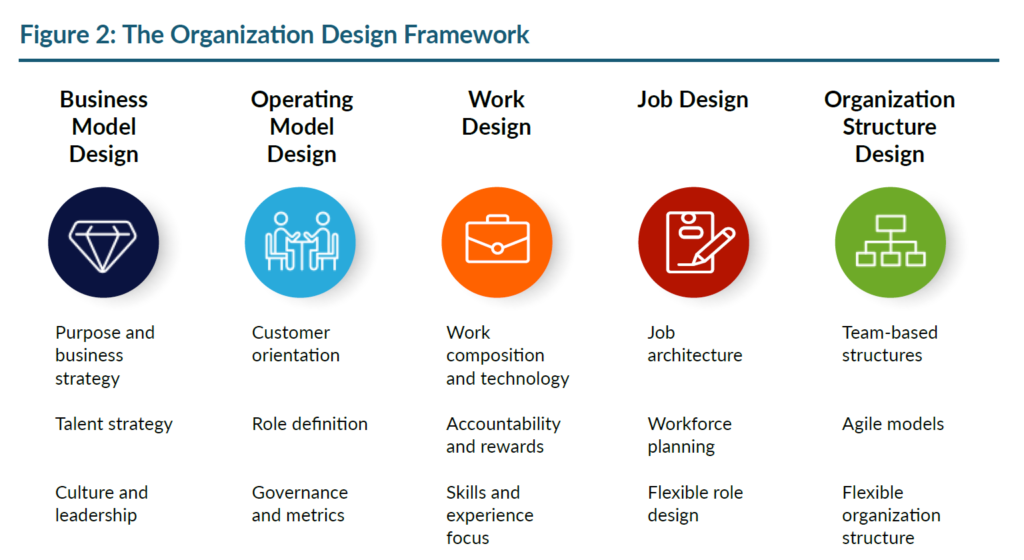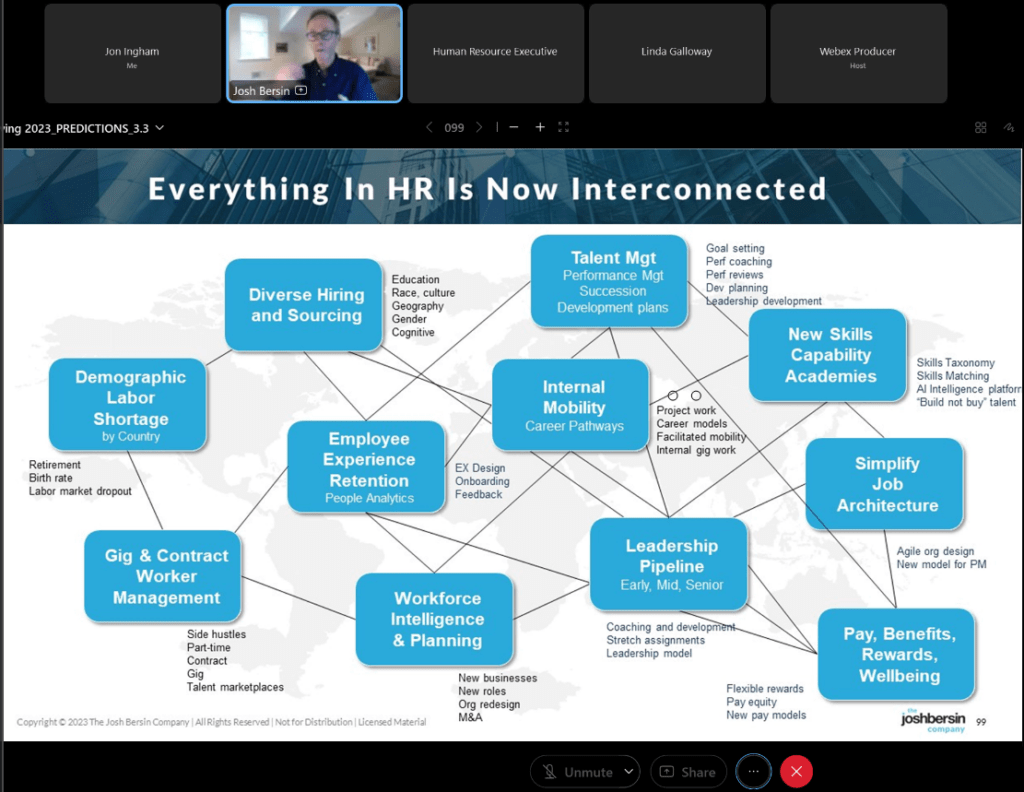On Josh Bersin Organisation Design

I notice I often get rather irritated when people call something authoritative, definitive, or something similar, or rubbish another perspective by calling it a myth or a lie. There are plenty of opportunities for different perspectives to thrive in this world, and the right solution is often a combination of opportunities, not one solution in preference to another. I get particularly irked when it’s clear the thing that’s proposed to be authoritative clearly isn’t.
This is a particularly important point in the field of organisation design. No one organisation is ever going to perfect and thus OD is all about combining the best of different opportunities and mitigating the downsides that comes with this choice. It’s also an area that is very prone to unhelpful dismissal of traditional approaches, often by linking the origins of vertically oriented, functional and heirarchical organisations to Taylor and Weber’s scientific management, even though today’s functional organisations often have very little of ‘command and control’ associated with them. And don’t get me started on the ‘death of jobs’ movement!
So, I’m going to provide some alternative (though definitely not definitive) perspectives to Josh Bersin and Kathi Enderes’ Definitive Guide to Organisation Design: Redesigning The Organization: The New Secret To Growth. And Now It’s Urgent. – JOSH BERSIN. You can find out more on my perspectives on this in my book, ‘The Social Organization’, and in the Jon Ingham Academy’s programme on organisation, work and job design (starting shortly).
It’s not that Josh’s insights are myths or lies, and indeed, he makes some very good suggestions that companies need to take account of. However, he also suggests that “HR and business leaders across all industries and around the world are thoroughly confused” and I worry that his guide will add to that confusion.
So, first of all, what do I like about this document?
- The key question definitely is “how do we organise for success”, so the guide is definitely answering the right question.
- Great organisation design is (small a) agile and accountable.
- Too many companies do start organisation design by looking at structure, rather than the work, and then focus on functional design and then hierarchy and delayering.
- Employees do need to be involved in organisation design, though this is often difficult or impossible to do if people are going to lose their jobs. We need to do less restructurings where this is the main focus, and more positive organisational transformations.
- Organisation design is important, and it’s great to see Josh increase focus on this disciplines. Read his report, but do also reflect on the following (hopefully constructive) criticisms.
So, where do I think Josh has got things wrong?
- Both employee’s needs and capability considerations need to be seen as objectives for the design, but the employee perspective on this concerns much more than employee experience. We need to design organisations that enable employees to achieve their objectives, not just feel nice whilst doing it. Well designed functional organisations don’t necessarily block adaptation, stop rewarding people quickly or hinder encouraging people to stay.
- All Josh’s guides are based on maturity models. These rarely make sense to me, and especially in OD, because this is such a broad field, many companies do well in a particular area, and much less so in another. Also, there’s not a single journey that every organisation is on, and not all roads point to (big A) Agile (as in “should you go all the way to a full agile model and create squads, tribes, and cross-functional guilds”).

- In particular, functional hierarchies aren’t defunct or invalid. They have increasingly serious drawbacks, but still make best sense in many areas of business. They may have emerged in the Industrial Age “when the manager’s role was defined by deciding what work needed to happen and then passing that down to labour” but that’s not the only way they work, and I’d suggest isn’t that prevalent today. They’re not “integrated, hierarchical machines” and we don’t put people into jobs as if they were “cogs in a machine”. (To his credit, Josh doesn’t try to bring Weber or Taylor into this.) Knowledge environments can work fine with functional organisations. They don’t need to be highly top-down, filled with management approvals, committees and bureaucracy (though some of this will be needed). Writing that “there are few legacy functional hierarchies left” is just bizarre.
- Josh’s organisation design framework is good, but I’d suggest focusing on it the organisation model, not just an operating model. You could suggest that the organisation model is included within the operating model or work design, but this is organisation design, not just operations design or work design, so I think it can help substantially to clearly focus on the organisation model. The talent strategy should be part of or follow-on from the organisation model as it needs to link with other elements in the organisation. It may be that Josh misses the organisation model out because he thinks there’s only one valid model – agile teams. If this is so, that is an even bigger problem.
- The framework should also be more complex than it is. It’s not just left to right. The operating and organisation models, including the talent strategy, should inform the business model too. And detailed design doesn’t always start with the work. Sometimes, and increasingly commonly, we need to start organisation with people, and their skills and connections, rather than with work.

- On agile teams, it’s not just agile organisations that separate work management from people management, it’s projectised ones. Most of what Josh writes about concerns moving from vertically to horizontally oriented organisations. Eg Josh suggests that “no matter how well you design the hierarchy, it starts to get in the way.” Actually, this isn’t really anything to do with hierarchy, it’s just about moving from vertical, functional specialisms (that are organised around specialisms, not really around top leaders) to horizontal organisation aligned with the work that needs to be done.
- But there are a number of different ways to be horizontally oriented, including process, project, agile, product management and autonomous team based. The split between work and people managers happens when you move from having people aligned with long-term processes to short-term projects. By the way, there are other options for organisation forms that Josh doesn’t refer to either. Vertical and horizontal orientation aren’t the only possibilities.
- Accountability is important, but the most important thing is ensuring that people are accountable for the right things. RACI analysis helps tidy up an organisation, but it doesn’t change an organisation’s strategic effectiveness. Also, Josh is right to say that this needs to be kept simple, but in very agile organisations, any sort of RACI can be too constraining (Kathi suggests this is a myth). And the point of accountability may increasingly be a team, not just a person. Rewards need to point in the right direction too, or at least not point in the wrong direction, but not all organisations will want to make reward such a prominent part of their organisation. To me, a big focus on reward suggests a move backwards to the rather mechanistic organisations that Josh refers to.
- Hybrid working does need to be included as an aspect of design, but it shouldn’t change the fundamental form. Deskbound and deskless staff can work in functions, agile teams and lots of other organisation forms. It’s also interesting that AI, automation and gig working isn’t part of this report. To me, these have bigger impacts on organisation design than whether someone has a desk, and where this is located.
- Tools like ONA and analytical systems like OrgVue can be useful, but aren’t usually necessary. This is particularly so given the increasing opportunity to transform organisations, not just tinker with them. Eg a network analysis can help you improve the way an organisation works – it doesn’t tell you how to organise (unless you’ve completely lost the plot strategically). Talent intelligence, ie seeing what skills are in the market, is also helpful, and may be essential, depending on what you’re trying to reorganise, but saying that you’re “flying blind” without it is a huge overstatement. And talent marketplaces are brilliant, and to me, have ushered in to the next phase of horizontal organisation (as well as providing other benefits), but they’re not “indispensable for matching people with capabilities”. Professional firms were doing this (admitedly, fairly poorly) for decades without these systems. Especially as marketplaces are probably going to be based on skills, not capabilities, which as Josh notes, are very different things.
There you go. Bersin’s document is a good guide, and it you want to understand organisation design (and you should want to), you should definitely read it. Just carry on reading and learning once you’ve done that. And look to add new opportunities to your toolkit, rather than throwing all of your traditional approaches away. They’re not always as defunct as can be made out.
And do check out the Strategic HR Academy’s programme on organisation, work and job design (starting shortly). This programme takes you through both traditional and modern opportunities, extending well beyond the use of horizontal / agile teams in this report, and the network of teams Josh often refers too. It also shows you how you can organise both with and without jobs. And it helps you identify what sort of organisation you should use within your own business (which should not just be down to your sector).
Also, please don’t think I’m against modern organisational approaches. We need to investigate these much more than we typically do. I just don’t think it’s helpful to suggest that they are the only, or even the best solutions (unless we’re talking about a best fit approach for a particular organisation).
Jon Ingham
HR and OD Strategist, Trainer, Learning Facilitator at the Jon Ingham Strategic HR Academy
Update: I have been asked, very appropriately, about what my own beliefs in this space are. I’ve published these here: https://www.linkedin.com/pulse/jon-ingham-organisation-design-framework-jon-ingham .





